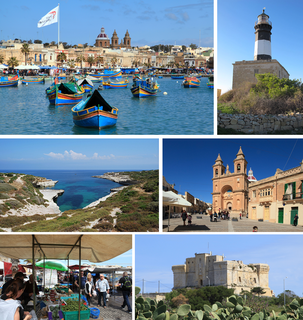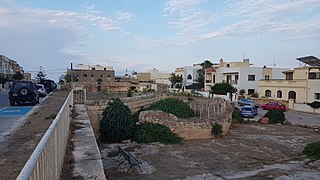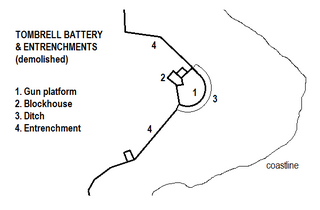
Marsaxlokk is a small, traditional fishing village in the South Eastern Region of Malta. It has a harbour, and is a tourist attraction known for its views, fishermen and history. As at March 2014, the village had a population of 3,534. The village is also known for the Marsaxlokk Market, which is mainly a large fish market which takes place along the seafront on Sundays, and a tourist market during all other days of the week. Inhabited and well-known since antiquity, Marsaxlokk was used as a port by Phoenicians, Carthaginians and also has the remains of a Roman-era harbour. Originally a part of the city of Żejtun, the fishing village became a separate parish in the late nineteenth century.

Rinella Battery is a Victorian battery in Kalkara, Malta. It is commonly referred to as Fort Rinella, although it was never classified as a fort while in use. It contains one of two surviving Armstrong 100-ton guns.

Fort Leonardo, also known as Fort San Leonardo or Fort San Anard, is a polygonal fort in Żabbar, Malta. It was built between 1872 and 1878 by the British between the villages of San Leonardo and Żonqor above the shore east of Grand Harbour.

Fort Ricasoli is a bastioned fort in Kalkara, Malta, which was built by the Order of Saint John between 1670 and 1698. The fort occupies a promontory known as Gallows' Point and the north shore of Rinella Bay, commanding the entrance to the Grand Harbour along with Fort Saint Elmo. It is not only the largest fort in Malta but also the largest in Europe, and it has been on the tentative list of UNESCO World Heritage Sites since 1998, as part of the Knights' Fortifications around the Harbours of Malta.

Fort Delimara is a polygonal fort in Marsaxlokk, Malta. It was built between 1876 and 1888 by the British as part of a chain of fortifications intended to protect Marsaxlokk Harbour. Today, the fort is still intact but is in need of restoration, and is in danger of collapse due to coastal erosion.

Fort San Lucian, also known as Saint Lucian Tower or Fort Rohan, is a large bastioned watchtower and polygonal fort in Marsaxlokk, Malta. The original tower was built by the Order of Saint John between 1610 and 1611, being the second of six Wignacourt towers.

Fort Saint Rocco, also known as Fort Saint Roca on some maps, is a polygonal fort in Kalkara, Malta. It is located east of Rinella Battery and seaward of the village of Santu Rokku, and forms part of the complex of shore batteries built by the British to defend the coast east of the mouth of Grand Harbour between the 1870s and 1900s.

Fort Tas-Silġ is a polygonal fort in Marsaxlokk, Malta. It was built between 1879 and 1883 by the British on high ground at the shoreward end of Delimara Point, above il-Ħofra-ż-Żgħira. Its primary function was as a fire control point controlling the massed guns of Fort Delimara on the headland below.

Saint Paul's Battery, also known as Ta' Lombardi Battery, is an artillery battery in Marsaxlokk, Malta. It stands on high ground at the shoreward end of Delimara Point, above il-Ħofra-z-Zgħira. It is a polygonal fort and was built by the British from 1881 to 1886. It commands a field of fire northwards over St Thomas' Bay and Marsaskala.

Fort Benghisa is a polygonal fort in Birżebbuġa, Malta. It was built between 1910 and 1912 by the British on high ground on the seaward face of Benghisa Point, the southern arm of Marsaxlokk Bay. It is the southernmost fortification in Malta.

Delimara Tower, originally known as Torre della Limara, was a small watchtower in Delimara, limits of Marsaxlokk, Malta. It was built in 1659 as the tenth of the De Redin towers, and an artillery battery was later built nearby in 1793. Both the tower and the battery have been demolished.

Żonqor Battery is an artillery battery in Marsaskala, Malta, standing on high ground overlooking Marsaskala Bay. It is a polygonal fort and was built by the British from 1882 to 1886.

Pembroke Battery was an artillery battery in Pembroke, Malta, Malta. It was built by the British between 1897 and 1899, and most of it was demolished in the 1980s.

Fort Campbell, also known locally as Il-Fortizza ta' Selmun, is a former fort in Mellieħa, Malta. It was built by the British between 1937 and 1938. It is notable as the most important fortification north of the Victoria Lines, and the last major fortification to be built in Malta. Today, it lies in ruins.

Tombrell Battery was an artillery battery in Delimara, Marsaxlokk, Malta. It was built in around 1722 by the Order of Saint John as one of a series of coastal fortifications around the coasts of the Maltese Islands. The battery was demolished at the end of the 19th century, and only its rock-hewn ditch survives today.

Wilġa Battery, also known as Saint James Battery or Zondodari Battery, is a former artillery battery in Delimara, Marsaxlokk, Malta. It was built in 1714 by the Order of Saint John as one of a series of coastal fortifications around the coasts of the Maltese Islands. Today, the battery's gun platform is largely destroyed, but its blockhouse remains intact and has been restored.
Spinola Battery, also known as Fort Spinola, was an artillery battery in St. Julian's, Malta. It was built by the British between 1889 and 1894, and it was demolished to make way for hotels and a yacht marina.

Pinto Battery, also known as Għżira Battery or Kechakara Battery, is a former artillery battery in Birżebbuġa, Malta. It was built by the Order of Saint John between 1715 and 1716 as one of a series of coastal fortifications around the coasts of the Maltese Islands. The battery has been heavily altered over time, and the blockhouse now houses a bar and a garage, while the gun platform and parapet have been largely destroyed, with only the general outline still visible.
Fresnoy Redoubt, also known as Kalafrana Redoubt, was a tour-reduit in Birżebbuġa, Malta. It was built by the Order of Saint John in 1715–1716 as one of a series of coastal fortifications around the Maltese Islands. It was demolished in 1897.

Wardija Battery was an artillery battery in Wardija, a hilltop in the limits of St. Paul's Bay, on the northern coast of Malta. It was built by the British in 1915, and saw use during World War I. It became obsolete following the construction of Fort Campbell in 1938.


















